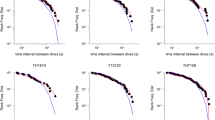Summary
Certain aspects of the problems connected with vertical migration were investigated by a new method. The experimental animals were adult males of the spring and summer populations ofCyclops abyssorum praealpinus (Kiefer) andCyclops vicinus lobosus (Kiefer). The swimming traces were for the first time observed continually over a period of about eight minutes and photographically recorded, without exposing the animals to additional stimulus from the recording technique. The animals' natural biotope was imitated as closely as possible and experimentally stabilised so that irradiance reductions were the only stimulus. The results can be summarised under three headings:
The direct result of an intensity reduction was a passive sinking of the animals, which we have called the “wait and see”-effect. It depends mainly on the relative reduction of intensity and, to a small extent, on the basic intensity.
The later, more prolonged upward movement, which we call the “swimming-up”-effect, depends mainly on the prevailing irradiance.
If the irradiance is constant, the animals swim for a considerable time in a restricted region, termed the “lingering-space”. Its dimensions are determined by the direction-dependent swimming velocities. These velocities vary according to the species and the time of the year.
As expected, the animals showed no horizontal orientation behaviour, nor were they influenced by the short-wavelength infra-red light used for photographing. An endogenous rhythm was only barely perceptible.
These results were analysed exclusively by modern statistical techniques.
Résumé
Certains aspects des problèmes de la migration verticale sont étudiés dans ce travail en se servant d'une méthode nouvelle. L'auteur a choisi pour ces essais des mâles adultes deCyclops vicinus lobosus (Kiefer) ainsi que ceux provenant de populations printanières et estivales deCyclops abyssorum praealpinus (Kiefer). La trajectoire de natation a pu, pour la première fois, être continuellement observée et photographiée pendant une période d'un peu plus de huit minutes, sans que les animaux aient subi une excitation supplémentaire due aux techniques de registration. Le biotope naturel des animaux a été imité au plus près possible et stabilisé de telle sorte que seule restait comme stimulus une diminution de l'éclairement énergétique. Les résultats, analysés à l'aide de méthodes de statistiques les plus récentes, se laissent grouper comme suit:
A la suite de la diminution de l'intensité, les animaux coulent; nous avons appelé ce phénomène: «wait and see». Il est surtout fonction de la grandeur relative de la diminution d'intensité et, dans une mesure plus faible, de l'intensité de base.
Il est suivi d'une nage ascendante prolongée; nous avons appelé ce phénomène le: «swimmingup». Il dépend surtout de l'éclairement énergétique ambiant.
Lorsque l'intensité d'éclairement est constante, les animaux nagent, pendant une période prolongée, dans un espace restreint, appelé «lingering-space», dont les dimensions dépendent des vitesses de nage dans les différentes directions. Ces vitesses varient suivant les espèces et les saisons.
Dans les conditions expérimentales choisies, les animaux, comme prévu, ne montrèrent pas de sens d'orientation horizontale; ils ne furent pas influencés par les rayons infrarouges de courte longueur d'ondes employés pour l'enregistrement et un rythme endogène ne fut qu'à peine perceptible.
Les résultats furent analysés exclusivement au moyen de techniques modernes de statistiques.
Similar content being viewed by others
Literaturverzeichnis
Le BaronCuvier,Le Règne animal distribué d'après son organisation, 2. Aufl. (Latreille, Paris 1829), Bd. 4, S. 170.
F. Ruttner, Int. Rev. ges. Hydrobiol.2, 397 (1909).
U. Einsle, Gewässer und Abwässer39, 40 102 (1965).
R. Schröder, Arch. Hydrobiol. Suppl,25, 401 (1962).
A. C. Hardy undR. Bainbrindge, J. Mar. Biol. Ass. U.K.33, 409 (1954).
J. E. Harris, J. Mar. Biol. Ass. U.K.43, 153 (1963).
J. Ringelberg, Neth. J. Mar. Res.2, 319 (1964).
G. Sterba, Bull. Inst. océanogr. Monaco, No spécial 1D (1960).
E. R. Baylor, Limnol. Oceanogr.4, 498 (1959).
D. Scheffer, P. Robert undJ. Medioni, C.r. soc. biol.152, 1000 (1958).
R. Schröder, Arch. Hydrobiol. Suppl.25, 1 (1959).
D. C. McNaught undA. D. Hasler, J. Fish. Res. Bd Can.21, 291 (1964).
J. R. Strickler,Experimentell-ökologische Untersuchungen über die Vertikalwanderung planktischer Crustaceen, ETH-Diss. Nr. 4387 (Juris-Verlag, Zürich 1969).
A. Linder,Planen und Auswerten von Versuchen, 2. Aufl. (Birkhäuser Verlag, Basel 1959).
O. Storch, Verh. dtsch. zool. Ges.1929, 118 (1929).
U. Einsle, Arch. Hydrobiol.60, 133 (1964).
J. Jacobs, Arch. Hydrobiol.62, 467 (1967).
A. Linder,Statistische Methoden für Naturwissenschafter, Mediziner und Ingenieure, 4. Aufl. (Birkhäuser Verlag, Basel 1964).
M. J. R. Healy,Mathematics and computer science in biology and medicine (Medical Research Council, 1965), S. 93.
J. Ringelberg, J. v. Kasteel undH. Servaas, Z. vergl. Physiol.56, 397 (1967).
O. Siebeck, Int. Rev. ges. Hydrobiol.45, 381 (1960).
J. E. Harris andU. K. Wolfe, Proc. Roy. Soc. B144, 329 (1955).
G. L. Clarke undR. H. Backus, Bull. Inst. océanogr. Monaco64, No 1318 (1964).
Author information
Authors and Affiliations
Rights and permissions
About this article
Cite this article
Strickler, J.R. Über das Schwimmverhalten von Cyclopoiden bei Verminderungen der Bestrahlungsstärke. Schweiz. Z. Hydrologie 32, 150–180 (1970). https://doi.org/10.1007/BF02502402
Received:
Issue Date:
DOI: https://doi.org/10.1007/BF02502402




